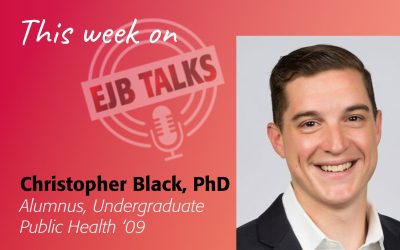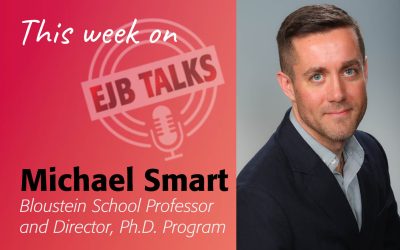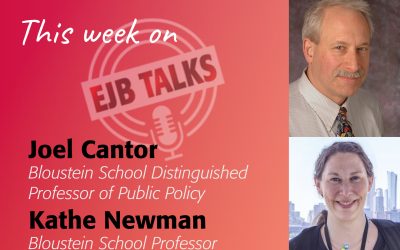We are opening our sixth season of EJBTalks with Stuart Shapiro, Interim Dean of the Bloustein School welcoming Kathy Krepcio, Executive Director of the Heldrich Center for Workforce Development to talk about the incredible workforce research and scholarship conducted by the center. Kathy describes Heldrich’s extensive work on unemployment and long-term unemployment and helping dislocated workers. The Heldrich Center has worked with those laid off after the September 11 attacks and has managed the New Start Career Network, which helps long-term unemployed New Jerseyans over the age of 45. They discuss the center’s new work, a study that aims to assess opinions of diversity, inclusion, and equity and evaluate responses by race, gender, income, and education to be used to promote more equitable workplaces and economic opportunities and funded by the Urban Institute’s WorkRise effort. Kathy and Stuart also talk about the center’s pandemic-related work researching how New Jersey delivered services to individuals eligible for benefits under the Federal Workforce Innovation Opportunity Act.
Stuart Shapiro
Welcome to EJB Talks. I’m Stuart Shapiro, the Interim Dean of the Bloustein School, and the purpose of this podcast is to highlight the work my colleagues and our alumni in the fields of policy, planning, and health are doing to make the world the country and New Jersey a better place.
We’re starting a new season. I have a new job title. And most importantly, we are going to be focusing on the wonderful work done by the research centers here at the Bloustein School over the course of the next eight to 12 weeks. Today, my guest is Kathy Krepcio, the director of the Heldrich Center for Workforce Development. Welcome, Kathy.
Kathy Krepcio
Thanks, Stuart. I’m happy to be here.
Stuart Shapiro
So let’s start by letting our listeners know… We’ve had Carl [Van Horn] on before so they’ve heard a little bit of Heldrich’s work, but they may not have tuned into that episode for whatever reason. So let’s start with some introductory stuff. And let me know what the mission of the Heldrich Center is, and what you do there.
Kathy Krepcio
Well, the Heldrich Center is a university-based research center in the Bloustein School that provides an independent source of analysis for reform and innovation in the public US workforce system. Its mission is to raise the effectiveness of the ever-changing American workplace. We do that by strengthening workforce education and training and enhancing equitable access to quality job opportunities for unemployed Americans and American workers.
For the most part, our mission is having like three activities. We really work to create a national center of workforce policy and practice and scholarship. We work to translate our research into effective public policy and practice where we can. And we serve as a public forum for the presentation discussion of key workforce development policy issues affecting both New Jersey and the nation. My job, I am the Executive Director of the Center, Carl Van Horn is the Faculty Director. I’m also a senior researcher at the center, and my area of expertise has been welfare reform, unemployment and disability employment, and older workers.
Stuart Shapiro
Great, that is a lot on your plate. There are a lot of those subjects that are very relevant right now. So let’s move through a few of the things you’re working on. I’d love to get to everything Heldrich does, but we’re not going to make this a five-hour podcast, we’re gonna make it a 20 minute one.
Let’s start with unemployment because that’s one of those things that resonates the most with the public. You guys have done a lot of work on long-term unemployment over the past several years… decade, I think even reaching back to the 2008 recession. What work are you doing now in that area, particularly as it pertains to older workers?
Kathy Krepcio
Well, as you said, one area where the center has really deep subject matter expertise is an understanding of both unemployment and long-term unemployment, and the dislocated worker experience, which is also another fancy phrase for a laid-off worker. With, as you say, with special expertise, we’ve been studying older workers in dislocation for about 15 to 20 years now. Over the years, we’ve published research on public policy related to helping dislocated workers. And we have direct experience serving unemployed individuals. So we’ve not only been studying it from a research perspective, but we’ve been living it.
For example, the Heldrich Center ran the September 11 funds massive Employment Assistance Program right after 9/11. I was the project manager for that. We spent a couple of years in New York City and Long Island and New Jersey trying to help those who’ve been laid off because of the September 11 attacks, try to get back to work. We also, right now, have been running for the past six years a program that is completely privately funded, serving New Jersey’s long-term unemployed over the age of 45, called the New Start Career Network. And the interesting thing about the New Start Career Network is not only is it a program directly for long-term unemployed over the age of 45. It’s been completely virtual… virtual before the pandemic. And we also operate it as sort of a research lab where we have been studying and looking at, over time, how long-term unemployment has affected workers and how it has affected their job search. It’s been a very, very interesting project for us.
Stuart Shapiro
How has the pandemic affected this area, particularly the long-term unemployed?
Kathy Krepcio
Well, it’s kind of strange to say, but it’s been better for them in some ways because the labor market is so tight right now. And so perhaps six years ago, we would have 1000s of people signing up to be members of our New Star program. Now, it’s 200 at best. And so what we’re seeing is because the labor market has been tightening, our workers are getting jobs, our unemployed workers are now getting jobs. We’ve noticed that there are more employers reaching out to us to try to post jobs. We noticed more and more of our workers, as I said, have become employed, which is a good thing. We’re happy about that.
Stuart Shapiro
Right. Yeah, and that sort of comports with what we understand about what’s going on nationally. The very tight labor markets and we’ll see if that holds into the recovery from the pandemic, but it has been an excellent outcome thus far, one of the only good things to see in the past couple of years.
Another issue that is “hot”, certainly is workplace discrimination. We had Professor Crowley a while back who talked about sexual harassment in the workplace; obviously, racial discrimination is very much in the news. You recently got a grant to study workplace discrimination. Can you tell us what the grants is for what you plan to study?
Kathy Krepcio
Sure. The grant is called… it’s a federal program funded by the Urban Institute called WorkRise. And we’ve named it a Workplace Divided. And it’s set to look, to document how US workers perceive and experience racial inequities in the workplace through a nationally representative survey of Black, Latino, Asian American, and White workers. The findings will be used to inform future program development, policy change and guide future research so that we can try as a country to promote more equitable workplaces and economic opportunities.
It is a survey. It will examine perceived discrimination. It will assess opinions of diversity, inclusion, and equity and evaluate responses by race, gender, income, and education. We just received this grant. So it’s a two-year project funded, as I said, by the Urban Institute. We’ve just started the design phase. And it’s being led by Dr. van Horn and Dr. Ron Quincy, both affiliated with the Bloustein.
Stuart Shapiro
Right.
Kathy Krepcio
We’re very excited about that project.
Stuart Shapiro
Yeah, both previous guests on this podcast, too. And so what kind of sample are we talking about? What kind of workplaces are we going to be looking at? What do you think they’re going to find?
Kathy Krepcio
We haven’t made all those decisions yet …
Stuart Shapiro
OK.
Kathy Krepcio
… it’s a little premature. And we’re not surveying workplaces as much as we’re surveying individuals. So we will be like I said, we just received the grant, maybe we can come back, and Carl or Ron can come back at another time and talk about the progress of that sometime in the late summer and early fall. But you know, it is interesting. You know, one of the things we saw in the New Star Career Network project is, you know, there was a lot of age discrimination out there as well. And we’ve talked about various types of discrimination. A lot of the laws are pretty weak in both the age discrimination in some instances, the subtle racial discrimination that take place in the hiring process. So we’re really, and it’s… both of these areas regarding age and race and discrimination are really interesting research areas. And we’re really excited to be working in this space.
Stuart Shapiro
Yeah, no, it’s a relatively new one for you all from what I can tell. And it’s really obviously important. I do think we’ll have to book Carl and Ron for the late summer there.
You do a lot of program evaluation for the State Department of Labor as well, sort of trying to figure out what works and what doesn’t work. Can you give us a few examples of that?
Kathy Krepcio
Sure. You know, evaluation and independent evaluation are actually one of our core functions at the center. And we have evaluated probably 100 different kinds of workforce and employment programs in New Jersey and across the United States. So, unfortunately, the majority of our evaluation reports are proprietary to the grant sponsor, but we have conducted evaluations that look at and make recommendations to program operators. And more recently, as you mentioned, the state of New Jersey. We have a long history of working with the state of New Jersey, the State Employment Training Commission, and the Department of Labor to look at their programs.
So for example, we recently completed an evaluation of what’s called their adult literacy program, which is funded by the federal government, the Workforce Innovation and Opportunity Act. That should be released, it is a public report, it should be released probably hopefully in the next six months. We are in the process of evaluating New Jersey’s reemployment assistance program for those who are on unemployment insurance. And there’s this process by which people on unemployment go through a profiling process to see if they’re more likely to stay on unemployment insurance. Those who’ve been profiled to maybe be more likely to exhaust their benefits after 26 weeks are then referred to these career counselors for the state for reemployment assistance. And so we are beginning the process of doing a rigorous evaluation, the experimental design of that process.
And now, we’re also in the process of looking at how the state of New Jersey delivered services to folks who were eligible for the Federal Workforce Innovation Opportunity Act, both during the pandemic when they shut down all physical operations and provided a lot of services virtually, and then how they’re doing it now. And then we’re gonna look at some data to see how they serve people before that period. So those are three really interesting evaluations.
Stuart Shapiro
That brings out the public policy nerd for sure, which is never that far from the surface, to be honest. But the challenge in program evaluation is, you have a before and you have an after, but how do you figure out whether the after is different than the before because of the program? Or because of other factors entirely?
Kathy Krepcio
Well, you know, it’s enormously difficult. And one of the challenges is working with these grant sponsors, and having them even understand what evaluation is and what evaluation isn’t. And so some of it is, you know, for example, in the Labor Department, they wanted us to evaluate, you know, did virtual services work better than in-person services? We couldn’t go back… we don’t have the Superman Wayback Machine or something to go back and say, “Oh, this is what it looked like pre-pandemic”, we can’t do that.
But we can look at some of the outcome data and see if we can make some inferences that way. But it is a challenge to work with some of the program sponsors who don’t really understand evaluation. And we spend a lot of time parsing out; what are the research questions that they really want to know? For the most part, we do a lot of implementation evaluations; How did the program go? How did it get implemented? Did it get implemented to its design or not? And then we can look at some basic outcome data because we have part of the center, we have all of the Unemployment Insurance wage records, which is the data that employers who are covered by unemployment insurance sent to the State on a quarterly basis of industry in wages. We had those dating back to the late 1990s. So we can, if we have social security numbers, we can look at people who are in those programs, and see over a period of time, whether they’ve been employed in the state of New Jersey, I should say, and what their wages are and what industry they’re in. And so we do have some administrative data to work with.
Stuart Shapiro
Yeah, we all have this human tendency to crave simple explanations. We see comparing online versus in person, we see a difference or like, “well, that’s because we were online now”. But God knows there’s been so much else happening over the past couple years, that it’s, it’s not necessarily. It may be that, but…
Kathy Krepcio
Well you know, some of it’s the quality of the data. We spend a lot of time trying to explain what the data that they have, that these operators have, can and cannot tell them because sometimes they don’t ask, their administrative databases, don’t tell them what they want to know. And I think the other thing is the challenge of operating, doing a program evaluation during a pandemic. I mean, we do evaluations for the Kessler Foundation on their disability employment programs. And traditionally, we would have done a site visit. And we would have done in-person interviews with the program operators and with the participants. And during the pandemic, we could do none of that. So we had to interview everybody via zoom, we couldn’t do focus groups like we wanted to. So it really made us shift our methodology. And I don’t think it’s suffered as much but certainly, you know, there is a difference between going to a program operation and eyeballing the offices and how people interact versus doing something virtually. It was definitely a challenge.
Stuart Shapiro
Yeah, I’m sure you’ve talked a lot about data. And really data is central to all of these things you’re talking about. It’s not the sexiest area, we generally wouldn’t build a podcast around it, but it is really important. And it’s, I know you’ve done a lot of work trying to improve workforce data. Can you talk a little bit about that?
Kathy Krepcio
Sure. There was a couple of things that we’ve done. And one of the things we’re very, very proud of is over the years, probably for the past 10-15 years, the federal government, both the US Department of Labor and the US Department of Education have been putting money into having states develop what’s called Statewide Longitudinal Data System. Which is compiling all of the state administrative data, mostly in the education and workforce training area, and seeing how you can conduct research off of one or more of these data systems. A perfect example is, can we look to see who graduates from a New Jersey High School, and how do they fare in the labor market over time?
So New Jersey has been very, very blessed and very lucky to have gotten grants from the federal government since 2012. And working in partnership with the Heldrich Center, we’ve been developing a very large and very comprehensive New Jersey launch to the database in partnership with the New Jersey Department of Labor, the Commission on Higher Ed, the Department of Education, the Higher Ed Student Assistance Authority and motor vehicles, I should say. And you probably asked why motor vehicles? It’s because not all of these data systems have a common identifier, which is a social security number. In fact, the Department of Education, their student data has a special number, so we can’t match against individual social security numbers. So we use motor vehicle data to sort of use it to help us match people who’ve graduated from high school, and don’t ask me to explain the details of that.
But anyway, as of 2022, we have millions of individual-level state administrative data records from, as I said, unemployment insurance wage data, unemployment insurance claims data to post-secondary public enrollment, and completion data to all records of individuals completing high school in New Jersey. What we do at the Heldrich Center under Sean Simone, who’s our research director, we govern this data system in close partnership with those state agencies. We conduct research and program evaluations using two or more of those datasets. And, and I’ll say that, for example, if this is worth, this brings up the geek and you and the geek and my staff is we are about to release a New Jersey, higher education outcomes, very visual dashboard, using labor wage data and higher education data.
We’re also about to begin a process of soliciting targeted research from other researchers external to the Heldrich Center to conduct research using the data. And we’re sponsoring and training graduate students as interns to be placed in our state agency partners. So they understand and learn how to use the data as well and to build the capacity both at the Bloustein School and at the state agencies to understand how to better use administrative data and know what it is.
And then I’ll say one last thing. One of the things that we’re very proud of is it’s been very difficult to share data across state lines. You know, as you can imagine, New Jersey has a very mobile labor market. So there are lots of people working in New York, lots of people working in Pennsylvania. And so you take that UI wage records, we can only look at someone who got a job in New Jersey. But we really want to look at someone who also got a job in Pennsylvania and New York, for example. So we started the Eastern States Data Collaborative, and we’re working now with New York, Pennsylvania, Connecticut, maybe Rhode Island, maybe Delaware, maybe Maryland, maybe Virginia, to begin the process of how we can share data across state lines to look at some of these, you know, mobility issues and wage issues.
Stuart Shapiro
Great. Well, there is a ton of good stuff going on at the Heldrich Center. Thanks for coming on today and walking us through it.
Kathy Krepcio
Great! Thanks for having me.
Stuart Shapiro
Also, a big thanks to our production team, Amy Cobb and Karyn Olsen. We are back for our new season and we will see you next week with another talk from another expert at the Bloustein School. Until then stay safe.




